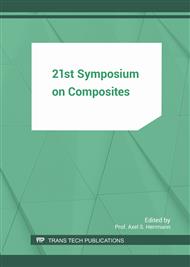p.215
p.223
p.231
p.238
p.246
p.255
p.263
p.271
p.278
Influence of Hardener Content and Curing Parameters on the Microstructure and Mechanical Properties of Porous C/C Composites
Abstract:
Carbon fibre reinforced carbon composites (C/C) are characterised by their excellent thermal, chemical and mechanical properties. The intrinsic porosity and fibre reinforcement grant them an excellent damage tolerance. The production of complex structures is time consuming and very expensive. An innovative approach to this topic is the integration of simple geometric ceramic composite materials within complex polymer structures. The motivation of this contribution is to investigate the influence of hexamethylenetetramine as hardener (hardener content: 4, 8, 12 and 16 %) and curing parameters (tempered and non-tempered) on the microstructure and mechanical properties of the porous C/C composites. During the course of this contribution, selected carbon fibre reinforced polymer (CFRP) composites with different porosities were produced while adjusting the resin or hardening agent-ratio, as well as the processing parameters. Subsequent to the curing of the CFRP samples, porous C/C composites were produced by means of a pyrolysis process. The final part of the contribution is comprised of the microstructural analysis by light microscopy and the explanation of the flexural strengths, by utilising a “three-point-bending test”.
Info:
Periodical:
Pages:
246-252
Citation:
Online since:
July 2017
Price:
Сopyright:
© 2017 Trans Tech Publications Ltd. All Rights Reserved
Share:
Citation:


